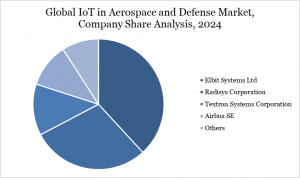Global IoT in Aerospace and Defense Market Surges Toward Integration of AI & Machine Learning | DataMIntelligence
IoT in Aerospace and Defence drives efficiency with predictive maintenance, connected systems, smart logistics, and enhanced real-time decision-making.
The increasing adoption of UAVs, drones, and autonomous platforms is creating demand for real-time monitoring and predictive maintenance solutions. Advances in communication technologies, including 5G, satellite IoT, and secure RF links, are enhancing connectivity and data sharing. Integration of AI, machine learning, and digital twin technologies is improving operational efficiency, threat detection, and mission planning. Additionally, cloud-based platforms and collaborations between defense contractors and tech providers are accelerating innovation and IoT deployment across the sector.
Download Latest Sample Report Pdf: https://datamintelligence.com/download-sample/iot-in-aerospace-and-defense-market
Advancements in Communication Technologies Driving Aerospace & Defense IoT :
Advancements in communication technologies are driving the IoT in Aerospace and Defense market by enabling seamless data sharing, real-time monitoring, and enhanced connectivity across platforms. For instance, PTC’s Aerospace & Defense Startup Program, announced at the Reindustrialize Summit 2025, supports early-stage companies in drones, space systems, and defense platforms by providing free access to PTC’s industry-leading design, product lifecycle, and compliance tools.
Such initiatives facilitate the development and integration of advanced communication solutions, allowing startups to create connected systems that improve operational efficiency, mission planning, and predictive maintenance in aerospace and defense applications.
Security Risks Associated with Advanced Technology Deployments
Security risks associated with advanced technology deployments act as a significant restraint on the IoT in Aerospace and Defense market. The integration of connected sensors, AI, cloud platforms, and autonomous systems increases the potential for cyberattacks, data breaches, and unauthorized access to sensitive military and aerospace information. Such vulnerabilities can compromise mission-critical operations, threaten national security, and lead to financial and reputational losses.
Expansion into Emerging Markets :
Expansion into emerging markets creates significant opportunities for the IoT in Aerospace and Defense market by opening new avenues for the adoption of connected technologies in countries modernizing their defense and aerospace capabilities. Nations in Asia-Pacific, Latin America, and the Middle East are increasingly investing in UAVs, drones, satellite systems, and smart defense infrastructure, driving demand for IoT solutions. These regions often face gaps in legacy systems, providing startups and established companies the chance to deploy advanced sensors, real-time monitoring, and predictive maintenance tools.
Collaborations between local defense agencies and global technology providers further accelerate market penetration. Additionally, emerging markets offer opportunities for cost-effective deployment of cloud-based platforms and AI-driven analytics. Governments in these regions are also implementing modernization programs and defense budgets that support innovation. The growing aerospace manufacturing sector in countries like India, Brazil, and Saudi Arabia adds to the demand for IoT-enabled fleet management and operational efficiency.
Accelerating Aerospace and Defense IoT Through Cloud-based Technology :
The cloud-based segment is a key driver of the IoT in Aerospace and Defense market, as it enables real-time data storage, processing, and analysis across globally distributed assets, enhancing operational efficiency and decision-making. By integrating data from aircraft, UAVs, satellites, and defense vehicles into secure cloud platforms, organizations can perform predictive maintenance, optimize fleet performance, and improve situational awareness.
Cloud solutions offer scalability to handle large volumes of IoT-generated data without the need for expensive on-premise infrastructure. They also facilitate seamless collaboration between defense agencies, contractors, and allied forces through secure data sharing. Moreover, cloud platforms support AI and machine learning applications, enabling advanced threat detection and mission planning.
The flexibility and accessibility of cloud deployments make them suitable for diverse aerospace and defense operations. Additionally, they help reduce operational costs while maintaining high reliability and security standards. Overall, cloud-based solutions are accelerating the adoption of IoT technologies in the sector by providing efficient, scalable, and secure connectivity.
North America at the Forefront of Connected Aerospace and Defense Technologies :
North America is a pivotal force in the IoT in Aerospace and Defense market, driven by substantial defense budgets, technological innovation, and strategic initiatives. In 2024, the U.S. Department of Defense allocated US$ 5.5 billion toward artificial intelligence, cloud computing, and emerging technologies, underscoring its commitment to digital modernization. Companies like Northrop Grumman and Lockheed Martin are at the forefront, integrating IoT solutions to enhance operational efficiency and data management capabilities for both military and civilian aerospace applications.
The region's leadership is also evident in collaborative efforts such as the partnership between Northrop Grumman and AT&T to develop a "military Internet of Things" using a 5G network to connect sensors, weapons, and data, aiming to create a "digital battle network" for enhanced operational capabilities. Additionally, Huntsville, Alabama, has emerged as a hub for innovation, particularly in AI-enabled fire control systems and scalable command architectures like the Integrated Battle Command System (IBCS), positioning itself at the forefront of modern air defense strategies.
Conclusion :
The Global IoT in Aerospace and Defense market is poised for significant growth, driven by rising defense budgets, technological advancements, and increasing adoption of connected systems across air, land, and naval platforms. Cloud-based solutions, AI integration, and digital twin technologies are enabling real-time monitoring, predictive maintenance, and improved operational efficiency.
Regions like North America and Asia-Pacific are leading adoption due to high defense spending, modernization programs, and strong collaborations between defense contractors and technology providers. Emerging markets offer new opportunities as countries upgrade legacy systems and invest in UAVs, drones, and satellite technologies. However, cybersecurity risks, high implementation costs, and regulatory challenges remain key restraints. Strategic partnerships, government initiatives, and startup programs are accelerating innovation and IoT deployment.
The growing focus on autonomous systems, secure communications, and data analytics further strengthens market potential. Cloud platforms are facilitating scalable, cost-effective, and secure data management solutions. Increasing investments in AI-enabled defense applications are improving situational awareness and mission planning. Thus, IoT is transforming aerospace and defense operations, enhancing connectivity, reliability, and decision-making capabilities. The market is expected to continue expanding as technological integration deepens across platforms globally.
Why Choose This Global IoT in Aerospace and Defense Market Report?
• Latest Data & Forecasts: In-depth, up-to-date analysis through 2032
• Regulatory Intelligence: Actionable insights on key policies (Kigali, AIM, F-Gas, ICAP)
• Competitive Benchmarking: Evaluate strategies of Chemours, Honeywell, and emerging players
• Emerging Market Coverage: Special focus on India, China, and high-growth APAC economies
• Actionable Strategies: Identify opportunities, mitigate risk, and maximize ROI
• Expert Analysis: Research led by industry specialists with proven track records
Empower your business to stay ahead of regulatory shifts, market disruption, and climate-driven trends.
Request your sample or full report today : https://datamintelligence.com/buy-now-page?report=aerospace-and-defense-fluid-conveyance-systems-market
Browse Related Reports :
Aerospace and Defense C Class Parts Market
Aerospace and Defense Fluid Conveyance Systems Market
Sai Kumar
DataM Intelligence 4market Research LLP
+1 877-441-4866
email us here
Visit us on social media:
LinkedIn
X
Legal Disclaimer:
EIN Presswire provides this news content "as is" without warranty of any kind. We do not accept any responsibility or liability for the accuracy, content, images, videos, licenses, completeness, legality, or reliability of the information contained in this article. If you have any complaints or copyright issues related to this article, kindly contact the author above.
EMDT Global Launches Next-Generation Portfolio Management Tools for Professional Traders
[CAGR of 12.2%] Microbial Cellulose Market Growth Worldwide, Major Trend Outlook, 2032
Carbonate Market Exclusive Report with Detailed Study Analysis
Więcej ważnych informacji
 Jedynka Newserii
Jedynka Newserii

 Jedynka Newserii
Jedynka Newserii

Finanse

K. Gawkowski: Polska w cyfrowej transformacji gospodarki awansowała do pierwszej ligi w Europie. 2,8 mld zł z KPO jeszcze ten proces przyspieszy
Uruchomiony na początku lipca przez Ministerstwo Cyfryzacji i BGK program „KPO: Pożyczka na cyfryzację” cieszy się dużym zainteresowaniem. Samorządy, uczelnie oraz firmy mogą wnioskować o wsparcie finansowe dla inwestycji w transformację cyfrową, m.in. modernizację infrastruktury czy cyberbezpieczeństwo. W sumie na ten cel trafi 2,8 mld zł (650 mln euro). Ze względu na krótki czas naboru obie instytucje organizują w poszczególnych województwach warsztaty dla wnioskodawców, które mają rozwiać ich wątpliwości przy przygotowywaniu wniosków.
Prawo
Koszty certyfikacji wyrobów medycznych sięgają milionów euro. Pacjenci mogą stracić dostęp do wyrobów ratujących życie

Od 2027 roku wszystkie firmy produkujące wyroby medyczne w Unii Europejskiej będą musiały posiadać certyfikat zgodności z rozporządzeniem MDR (Medical Devices Regulation). Nowe przepisy wprowadzają dużo ostrzejsze wymagania w zakresie dokumentacji, badań klinicznych oraz procedur certyfikacyjnych. Branża ostrzega, że część małych i średnich producentów nie zdąży się dostosować. Problemem jest także wysoki koszt i długi czas uzyskiwania certyfikatów. W konsekwencji z rynku mogą zniknąć urządzenia ratujące życie.
Infrastruktura
Nowe przepisy o ochronie ludności cywilnej wprowadzają obowiązkowe elastyczne zbiorniki na wodę. Mają one służyć w razie suszy, pożarów czy wybuchu wojny

Samorządy będą musiały posiadać m.in. elastyczne zbiorniki na wodę pitną i przenośne magazyny wody przeciwpożarowej. To element odpowiedniego przygotowania zasobów na wypadek sytuacji kryzysowych, kataklizmów czy wybuchu konfliktu, wprowadzony nowymi przepisami o ochronie ludności. Eksperci podkreślają, że tego typu rozwiązania to innowacyjne produkty, które nie tylko ułatwiają logistykę w sytuacjach kryzysowych, ale także mogą znacząco skrócić czas reakcji służb ratunkowych.
Partner serwisu
Szkolenia

Akademia Newserii
Akademia Newserii to projekt, w ramach którego najlepsi polscy dziennikarze biznesowi, giełdowi oraz lifestylowi, a także szkoleniowcy z wieloletnim doświadczeniem dzielą się swoją wiedzą nt. pracy z mediami.









.gif)

 |
| |
| |
|